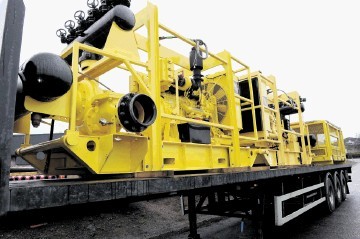
Gas pouring out of Total’s stricken Elgin platform could be stopped by the end of this month – if all goes to plan.
In an exclusive interview with the Press and Journal, Total’s UK managing director, Philippe Guys, said the firm’s main aim was to carry out a successful “dynamic kill” on the leaking G4 well before May.
Last night another specialist team flew to the installation to carry out inspections, cleaning work, and to record the pressure of the gas spewing out of the platform.
It was the second time engineers had been able to board the Elgin since all 238 staff were evacuated 17 days ago. Speaking at his Aberdeen office, Mr Guys said that although the shutdown was costing the firm nearly $1.5million (£940,000) a day, the main priority was stemming the leak safely.
He said: “The Elgin/Franklin is about 2% of the production of the Total group so it is a very important asset to us. And obviously now we have the cost of mobilising all the equipment. I couldn’t tell you the exact cost of it all, but it’s significant. But for the time being the priority for me is not to count the money we are spending, it’s to get a grab of this leak and stop it.
“I know the group is strong enough to support this as we have a very strong balance sheet.
“And let me tell you one thing, we won’t rush to get these things done if we can’t do it safely.
“But we are working hard and if all goes as planned we envisage by the end of this month we should be having control of the well.”
Mr Guys said problems started in February last year when the G4 well stopped producing following an “abnormal situation” and the firm decided to block the well using a steel plug.
This was not meant to be a permanent solution and the intention was to fully decommission and abandon the well at a later date. There appeared to be no issues with the well, however on February 25 this year Total noticed a “sudden increase in pressure in the annulus” which was when the company started to intervene. But it took more than a week to start work on the G4 as teams had to finish carrying out the job they were performing on another well – the G8.
Mr Guys said he believed the gas, coming from a chalky rock called the Hod formation, was getting into the well possibly through a crack or some other weakness in its carbon-steel outer wall. However, he said it was unlikely the high-quality carbon pipes had corroded.
Mr Guys said a recorded reduction in the pressure of gas escaping from the well could have been due to the lack of other substances leaking out along with the gas. He said: “We have seen a difference (in pressure) from the beginning and what we are observing now. However, it may be the content of the flow that has changed, like in the beginning you may have had a little bit of liquid like mud coming out, then what we are seeing now. Over the last few days we have not seen any significant change but there is still a possibility the formation will stop by itself.”
As about seven tonnes of gas are thought to be spewing out of the well every hour, it is estimated about 3,000 tonnes have escaped since the leak started on March 25. The results of a study into the environmental impact of the leak are expected to be released by the Scottish Government today.